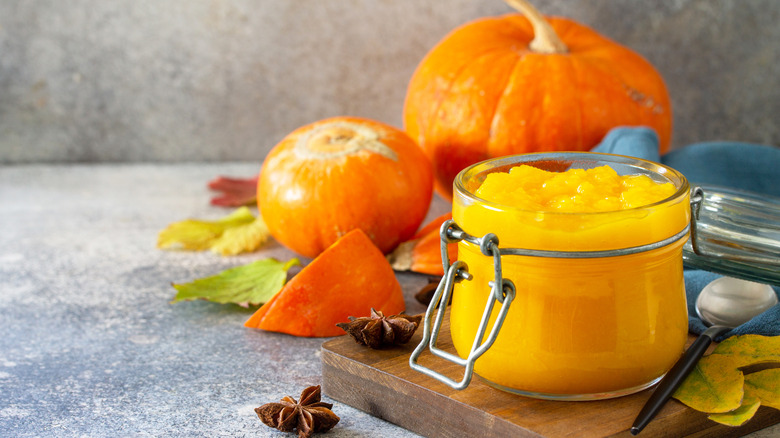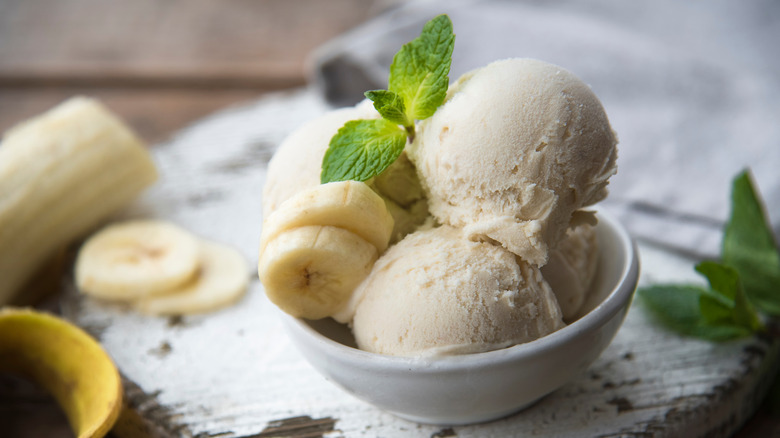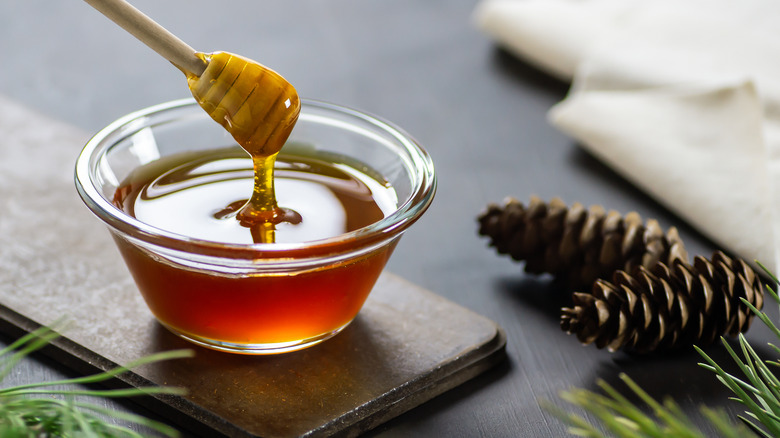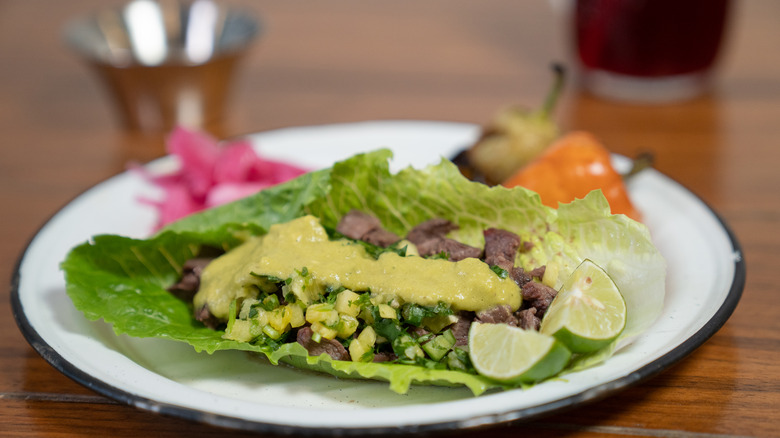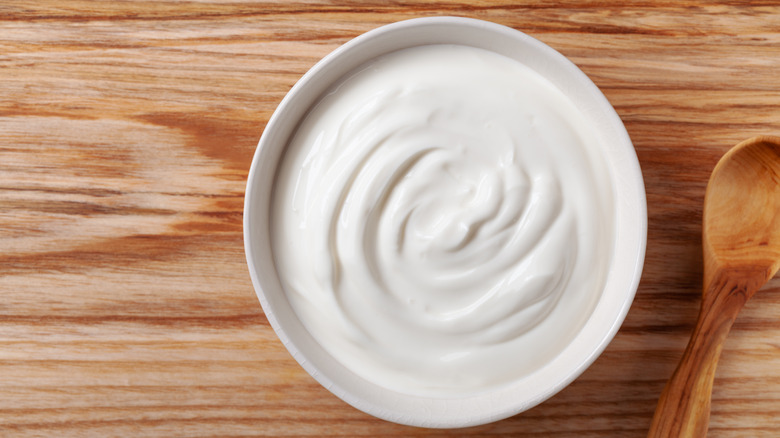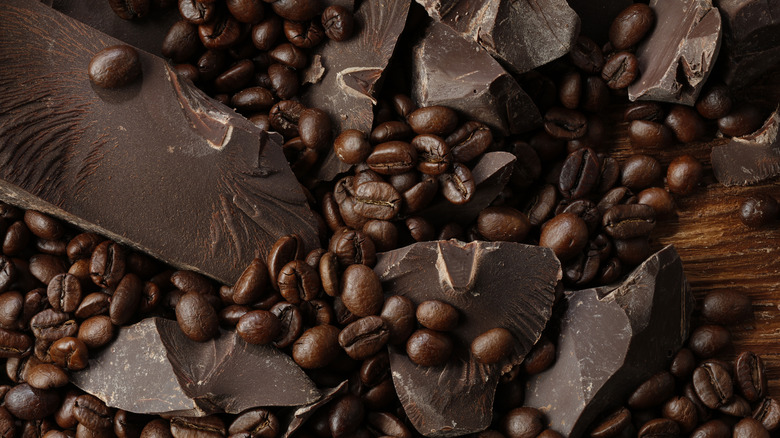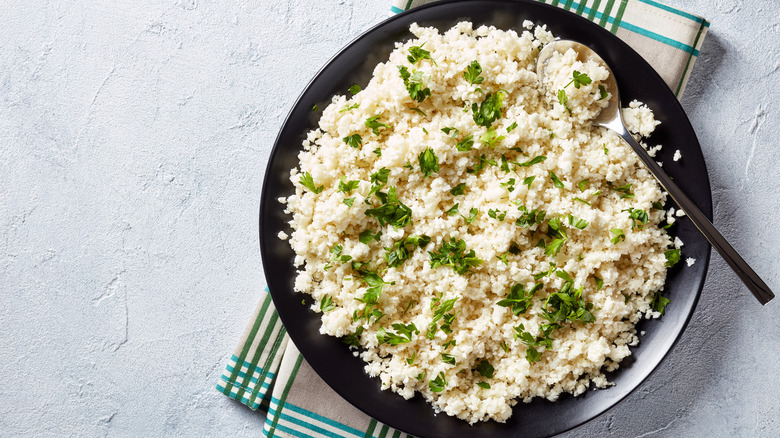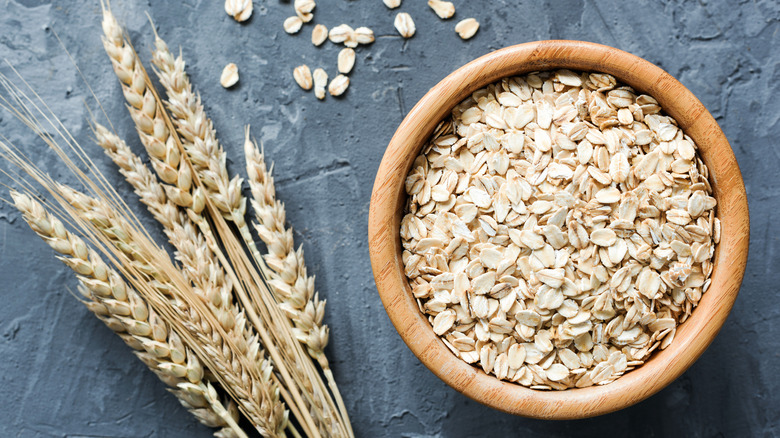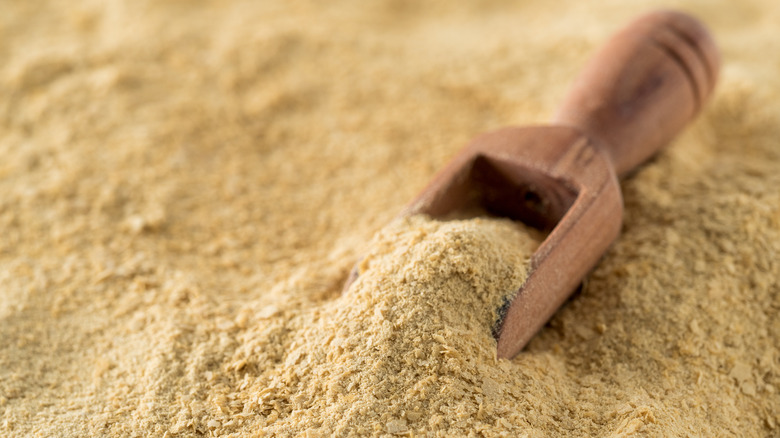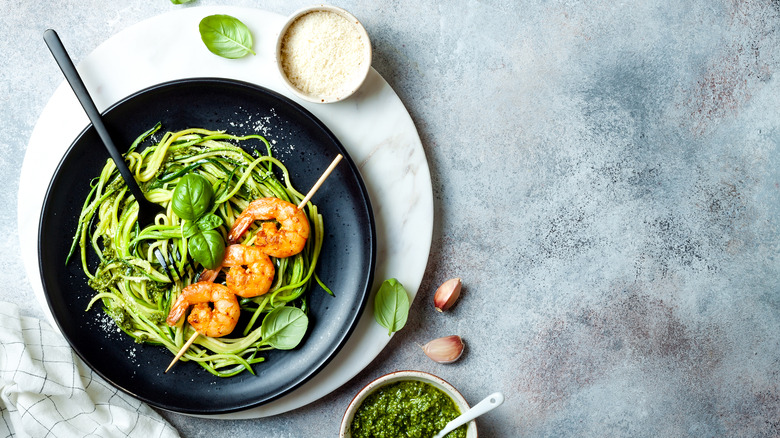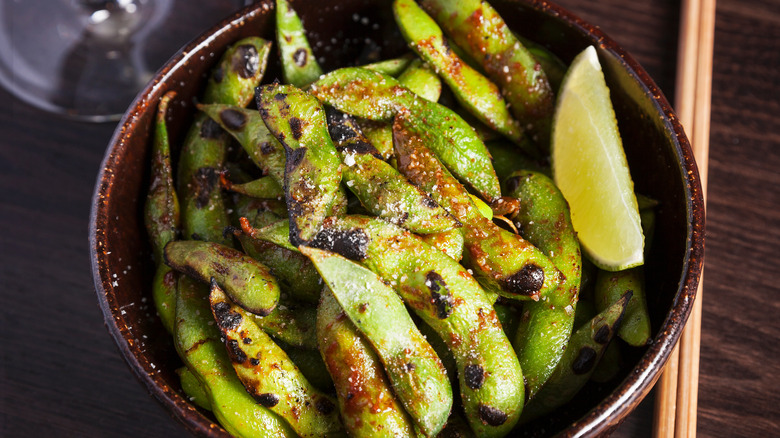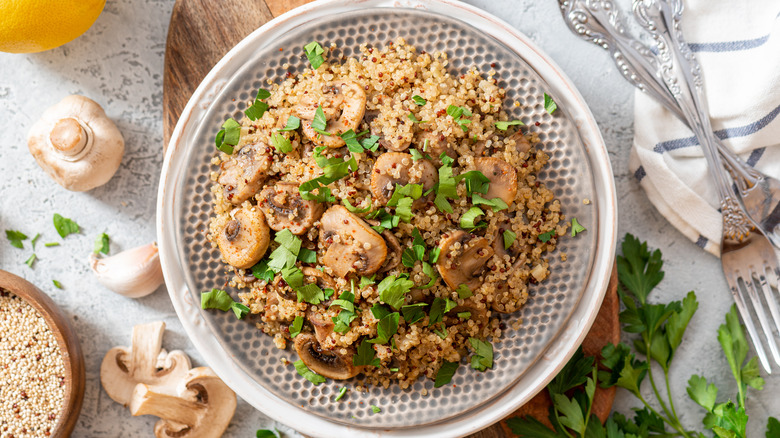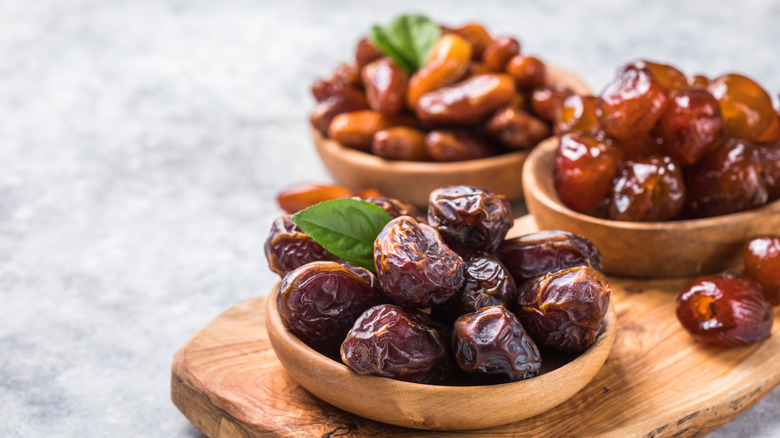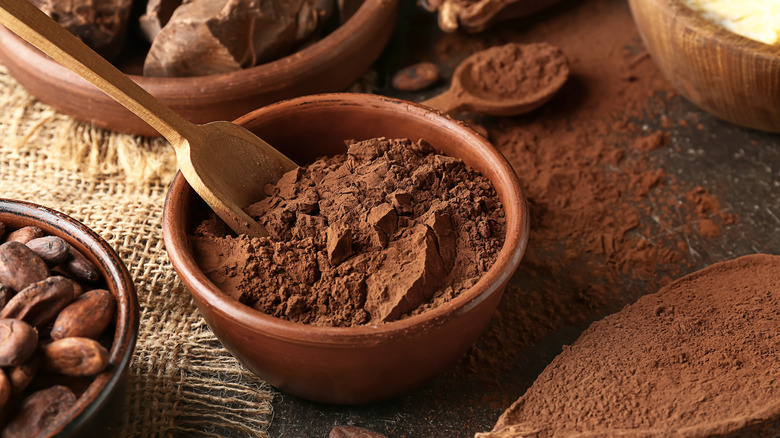Healthy Ingredient Swaps You Need To Try
Trying to live a healthier lifestyle is always a great idea. Any quick Google search will return millions of hits for ideas about how to start living your best healthy life. And it's with good reason, too. The choices we make now with regard to health could potentially dictate what happens later down the line, as Harvard Health Publishing points out. That's why starting with smaller things, like picking just one change to make to your health at a time, selecting achievable goals for your health, or breaking down seemingly large ambitions into smaller chunks (like aiming for a short walk instead of an hour-long run) is a great place to start.
And in the same vein, making smaller, healthier choices with your diet as opposed to trying to revamp it all in one go is not only way more of a realistic aim, but more beneficial than you'd think. These days, there's a multitude of healthy ingredient swaps you can make that can have your food tasting even better than normal, and that can expand your culinary horizons to places you never even thought. Take a look at some of our top picks here.
Try puréed pumpkin instead of oil in baking recipes
If you're a sucker for baked goods — who isn't? — you'll no doubt be aware of how much fat can go into these sweet treats. One standard serving of red velvet cake can contain up to 23 grams of fat, with potentially 4 grams of saturated fat and a not-insignificant amount of cholesterol, according to Livestrong.
Next time you have a hankering to bake, try replacing oil with puréed pumpkin. Puréed pumpkin (as well as other puréed fruits or vegetables) supply much of the same moisture that oil does in baked goods, but without the fat, according to Our Everyday Life. Bear in mind that you may still need to use a little bit of oil. Also, baking with pumpkin can speed up the cooking process somewhat and change the flavor somewhat. This means you might not want to add it to every treat you bake.
In addition to the fat savings, pumpkin is also naturally high in vitamin A, antioxidants, further vitamins and minerals like potassium, folate, and magnesium, and contains a good amount of dietary fiber, dietitian Jodie Yeo told Health XChange.
Got a craving for ice cream? Make it with bananas
Ice cream is pretty much the food of the gods, but like most things that are really super delicious, regrettably, it's pretty unhealthy. So what if we said you could make ice cream with just one ingredient? And a healthy one at that. It's true. All you need are some ripe bananas and a blender. Trust us on this one — it's gold.
Take the bananas, peel, and slice them. Place them in a freezer bag or container and throw them in the freezer for at least two hours. Once they're frozen solid, place them in the blender, and process, process, process. After a while, the banana will, quite magically, turn into an ice cream texture. Freeze it for a little longer and then enjoy: no fat, no added sugar, all taste.
Naturally, you can add anything you want to the dessert, like ice cream. And due to bananas being total health bombs that are high in fiber, antioxidants, and packed with vitamin B6 among various other benefits, according to San Diego-based nutritionist Laura Flores, this is essentially a health food in a delicious creamy vessel (via Live Science).
Squeeze in some honey instead of sugar
If a recipe calls for sweetness, it's hard to know what else to use other than sugar. While refined white sugar is undeniably delicious, it can come at a significant health cost, as a known association exists between sugar intake and diabetes, according to WebMD.
However, opting for honey instead of sugar can help to supply certain healthy elements that refined white sugar might not contain. Honey contains higher levels of vitamins and minerals, including magnesium and potassium, as well as amino acids and antioxidants (via Medical News Today). In addition, honey scores lower on the glycemic index (GI) than sugar, meaning that it won't raise your blood sugar as fast as table sugar.
Just because honey has more goodness in it, though, it doesn't mean that it's healthy in large quantities. Both honey and sugar are composed largely of the same substances: fructose and glucose. However, if sweetness in a recipe can't be avoided, consider using honey. When possible, opt for darker, raw varieties, as these will contain the greatest concentrations of antioxidants and vitamins.
Taco night? Use lettuce instead of hards shell or tortillas
There are few things more enjoyable in life than biting into a loaded taco. However, with three hard shells containing 3 grams of saturated fat and 19 grams of carbohydrates, looking for swaps to hold your fillings wherever possible can be a good option.
This is where the humble lettuce leaf comes in. Butter lettuce is "a great bread replacement for anyone looking to go low-carb," says Kelly Kennedy, registered dietitian and staff nutritionist for Everyday Health told the website. "You can make a traditional sandwich and serve it on butter lettuce, or even roll the ingredients inside the leaves to create a sort of 'wrap' in place of a tortilla."
What about iceburg lettuce? Kennedy acknowledged that it "can be used just like butter lettuce (as a salad, on top of a sandwich, or as a bread replacement)," but she tends to advise people to eat other greens instead. "I don't usually recommend iceberg lettuce because there's not much nutritional value to it — I usually tell people to just have a glass of water instead," she explained.
Go for Greek yogurt instead of sour cream
Swapping out sour cream for Greek yogurt as a topping for baked potatoes, stews, or even burritos is an excellent way to maximize your nutritional intake without losing any flavor. Greek yogurt (either full-fat or low-fat kinds) "provides an excellent source of protein and high fiber carbohydrates," nutrition expert Mina Khan told Good To. "It contains a great mix of vital minerals and vitamins, such as potassium, calcium, zinc, and vitamin B12."
Not only that, but you could reap the benefits that Greek yogurt has on your stomach by making this easy swap. "It's also packed full of probiotics (known as 'good bacteria') which helps aid digestion and keep our bowels healthy," said Khan. These probiotics help to boost your gut's microbiome, the healthy maintenance of which contributes to everything from keeping your immune system healthy to the proper processing of vitamins and minerals in your diet.
Greek yogurt is also generally lower in fat, cholesterol, and calories compared to sour cream — all while remaining high in protein (via Livestrong). Choosing a low-fat or nonfat Greek yogurt will bring down the fat and calorie levels even further.
Dark chocolate can help you get your chocolate fix in a healthier way
"Healthy chocolate" might seem like the biggest oxymoron ever, but subbing chocolate for a different type of chocolate is a quick swap that can boost your nutrient intake. Classic milk chocolate gets its rich flavor from its higher whole milk and sugar content, which comes at the expense of the chocolate liquor (a combo of cocoa butter and cocoa solids) that contains the good stuff, says Today's Dietitian. Dark chocolate contains at least 35% liquor, meaning it has a much higher concentration of the minerals and vitamins that cocoa provides.
A single one-ounce serving of high-cocoa dark chocolate contains 19% of your daily manganese intake, 17% of your copper intake, as well as magnesium, iron, potassium, zinc, selenium, phosphorous, and several types of B vitamins and vitamin K. The cocoa in dark chocolate is also a natural source of theobromine, a powerful antioxidant which can help to maintain healthy blood pressure and reduce inflammation. Bear in mind that dark chocolate has a more bitter taste than milk chocolate, so if you're swapping it in recipes, you may need to consider the sweetness of your meal.
Instead of white rice, try cauliflower rice
The humble cauliflower has been given new life recently, as more people discover the vegetable's ability to mimic higher-energy carbohydrate food sources seamlessly. Nowhere is this clearer with cauliflower rice, an ingredient swap that you won't regret. All you have to do is throw a broken-up head of cauliflower into a food processor and blitz it for a few minutes. Transfer to an oiled skillet, and fry gently (without browning it or overcrowding the pan) for five to eight minutes, then serve.
Not only is cauliflower an excellent source of fiber, potassium, and vitamins B6, C, and K, but a cup of cauliflower contains only 25 calories and just 5 carbs, according to Health. This makes it a perfect choice if you're on a keto or low-carb diet. Compare that to a cup of cooked white rice, which has over 200 calories and roughly 44 grams of carbs ( via Health). Plus, white rice is generally stripped of much of its nutrient content, due to the polishing process that occurs to change it from brown to white.
Rolled oats can replace breadcrumbs
Using breadcrumbs in dishes is tried and tested, but it comes at a cost. Pre-packaged breadcrumbs can often be treated with corn syrup, hydrogenated oils, and sodium, according to Livestrong. All of these ingredients can have negative consequences if consumed too regularly or in too-high quantities. Breadcrumbs also contain gluten, which can be a nightmare for people who have gluten sensitivity.
Oats, on the other hand, are pretty much the nutritional MVP. Not only do they contain excellent levels of soluble fiber, which can help to control blood sugar levels, contribute to proper digestion, and lower harmful LDL cholesterol, but they contain several key minerals like calcium, phosphorus, and protein to boot (per Good Housekeeping).
Try using oats as a binder in meatballs instead of breadcrumbs, as Good Housekeeping suggests, or as a topping for bread. If you're opting for oats to reduce gluten, however, be warned: "What many people might not know is that oats are inherently gluten free, but may come in contact with wheat, rye and barley at the farm, in storage or during transportation," Kristin Harris, senior principal scientist at Quaker, told the publication. Make sure the oats you choose are explicitly marked as gluten free.
Next time you have pasta, give nutritional yeast a try instead of parmesan
Some vegan options can be a great move nutritionally. "Nutritional yeast tends to be a staple in the vegan diet as many B vitamins are found in highest concentrations in animal products," registered dietitian Cayleih Mackay Nunn, who works with the University of California San Diego Health Nutrition Services, told UC San Diego Health. According to Nunn, vitamin B6 deficiency is particularly common amongst Americans, and nutritional yeast can rectify this as a "great source" of B6, as well as other B vitamins.
Adding to nutritional yeast's star power is its complete protein, containing the full set of amino acids needed by the body, registered dietitian Emily Kichler explained in an article for Chatelaine. For many people following a vegan diet, nutritional yeast is a direct swap for parmesan cheese — but bear in mind that on a calorie level, the two don't differ much. "Surprisingly, nutritional yeast is pretty similar to Parmesan cheese in terms of calories: two tablespoons of nutritional yeast equals 40 calories; the same amount of Parmesan cheese is also 40 calories," said Nunn.
Zucchini noodles work well as a spaghetti substitute
If you haven't tried zucchini noodles yet, we're prepared to go all in with the persuasion. There are a few reasons why zucchini noodles have become a much-loved straight swap for spaghetti, with the first one being, simply, the visual appeal. "We eat with our eyes, and it absolutely looks like pasta," registered dietitian Tanya Zuckerbrot, who practices in New York City, told Vogue. Subbing out something as beloved as pasta for something that looks identical to it can help you make a healthier choice without missing the noodles.
Zucchini noodles (or zoodles) are also a food sub that come packed with nutrients. With just 17 calories, a 1-cup serving of zucchini will deliver 40% of your daily recommended intake of vitamin A, and a high amount of antioxidants, particularly carotenoids (the pigments that give carrots their orange hue). Zoodles also provide soluble and insoluble fiber, which can aid with digestion and satiation.
It couldn't be easier to make zoodles, so don't be intimidated by the process: Simply grab a julienne peeler or a mandoline with a shredding attachment and place the zoodles in boiling water until just softened.
Have a bowlful of edamame instead of peanuts
A bowlful of salted, oily peanuts is obviously delicious as a bar snack (or an afternoon snack, bedtime snack, or 9:30 a.m. snack...). Eating them in moderation is generally okay, and peanuts do have some excellent nutritional benefits as a great source of plant-based protein, vitamins and minerals, and fiber, according to Medical News Today. Salted peanuts, however, come laden with — you guessed it — sodium, and consuming too much sodium over time is linked to hypertension and heart disease. A 1-ounce serving of salted peanuts contains 5% of your daily recommended intake for sodium, according to Eat This Much. And once you start snacking, it can be hard to stop.
Instead, take some edamame, coat them lightly in oil, salt, and your favorite spices, and roast them at 350 degrees Fahrenheit for 12 to 15 minutes. Not only are the soybeans much lower in fat and calories, but controlling the salt level yourself means you know exactly how much you're getting. What's more, these nutritionally dense beans deliver a huge amount of protein (a whopping 10 grams) and fiber (6 grams) in just a ½ cup serving, states Everyday Health.
Swap out rice for quinoa
Look, we hear you: it can be frustrating to swap out things like rice or pasta for vegetable alternatives and pretend that it's the real thing. That's why this swap is slightly closer to home, and one which we think you'll love. By swapping rice for quinoa, you maintain the grain aspect of your meal while making a healthier choice.
As a complete protein, quinoa delivers all of the nine essential amino acids that your body requires, which rice does not, according to UPMC. As you might assume, this also means that its protein content is higher than rice, with 8 grams per cup. Furthermore, the grain is slightly lower in carbohydrates and higher in micronutrients including zinc, manganese, magnesium, and iron. In fact, quinoa's nutrient content is around three to four times higher than brown rice — which means that it'll even higher than the content of white rice.
Quinoa also contains more fiber. Crucially, though, quinoa and brown rice have roughly the same amount of calories for an equivalent serving size, which means you won't be left unsatisfied in a way that other ingredient swaps can sometimes result in.
Instead of refined sugar, try dates
Fruit can often be used to sweeten up dishes, but few have as much of an effect as dates. In fact, dates are an excellent alternative to white refined sugar, either ground into a date sugar, as date syrup or simply by throwing chopped dates into your baked goods or meals, according to The Kitchn.
And alongside their natural sweetness, you'll also be gaining some impressive nutrition. Three dates contain a surprisingly large amount of fiber: 5 grams, or roughly 18% of your daily recommended intake, nutritionist Cynthia Sass told Health. This will help to support your digestive health.
In addition, a 2020 study published in Nutrients found that adults with type 2 diabetes who ate three dates per day for 16 weeks not only demonstrated a lower level of LDL ("bad") cholesterol, as well as a "significant" reduction in total cholesterol. Participants also reported feeling a better quality of life and improved mental health. This makes sense considering dates are also packed with natural antioxidants, helping to protect against oxidative stress and combat free radicals.
Next time you want to use cocoa, try cacao
Have you ever wondered what the difference between cocoa and cacao is? Turns out, it's more than just a two-letter difference. Both cocoa and cacao powder begin their lives as beans from the cacao plant, but cocoa is processed at a higher temperature than cacao, and can often have additions like sugar and dairy products, whereas cacao is processed at a lower temperature from beans that are fermented (per All Recipes).
Cacao ends up with a slightly more bitter flavor — but the difference doesn't stop there. Cacao powder is packed with flavonols, compounds that have an antioxidant effect on the body. Cacao also serves as a great source of magnesium, iron, and has a fiber content. Due to the intensive processing of cocoa, however, these qualities can be lost, and cocoa products can often have a higher caloric content due to added ingredients. Try using cacao in a healthier twist on a hot chocolate, or sprinkle it onto cakes or into desserts in place of cocoa. Just bear in mind that you'll lose some of the sweetness that cocoa supplies by doing so, so adjust your other ingredients accordingly if necessary.


